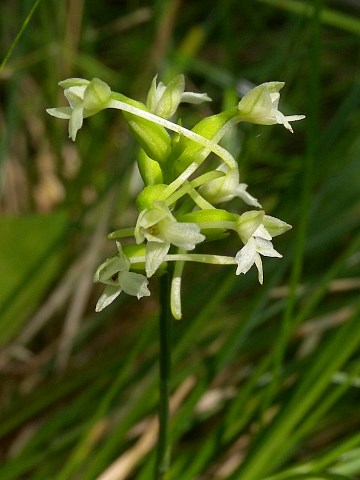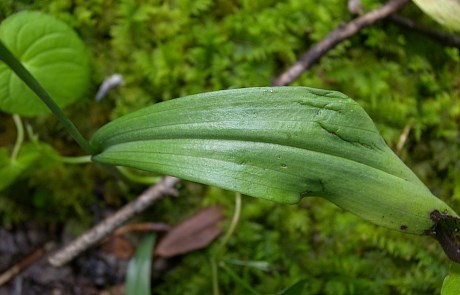
The central stalk terminates in a floral raceme about ¾-3" long; there are 5-20 greenish white flowers per raceme. The density of these flowers along the central stalk of the raceme is more or less moderate; they are nodding to ascending and often twisted to the side. Individual flowers are about 1/3" (8 mm.) across and 1/2" long, consisting of 3 greenish white petals, 3 petaloid sepals that are greenish white, a rather prominent green ovary, and other reproductive organs. At the base of each flower, there is an ascending lanceolate bract that is less than ½" in length. The upper 2 petals and upper sepal form a small hood over the nectar opening at the center of the flower, while 2 lateral sepals project forward and form a pair of wings. The lower petal forms a lip with 3 tiny lobes at its tip, while the posterior of the lower petal forms a long nectar spur (up to ½" long) that is often slightly swollen toward its tip; this spur usually curves gently downward, although sometimes it is nearly straight.

The blooming period occurs from mid- to late summer and lasts about 2-3 weeks. Sometimes there is a slight floral fragrance. In the absence of cross-pollination, the flowers are self-fertile, forming ovoid seed capsules about ½" long. The sessile seed capsules are ascending to nearly erect. Eventually, these capsules split open to release numerous tiny seeds that are distributed by the wind. The root system is fibrous.
Cultivation: The preference is light shade or partial sun, consistently moist conditions, and an acidic soil containing peat, sand, or moss. It is possible, although difficult, to propagate this orchid by seed if the latter is inoculated with the appropriate endomycorrhizal fungus (e.g., Eupulorhiza inquilina); see Zettler & Hofer (1998) for more information. This orchid does not transplant well.
Range & Habitat: The native Club-Spur Orchid is rare in Illinois and state-listed as 'endangered.' It is found primarily in NE Illinois. Populations have declined because of habitat destruction. Typical habitats include moist sandy meadows, edges of prairie swales, sandy pannes near Lake Michigan, peaty bogs, springs and gravelly seeps in wooded areas, and sandy swamps. In Illinois, this wildflower is found in high quality natural habitats.
Faunal Associations: Very little is known about floral-faunal relationships for this species. Because of the long nectar spur and general appearance of the flowers, they are probably cross-pollinated by moths. While the foliage and flowers are non-toxic, this orchid is usually overlooked by mammalian herbivores because of its diminutive size. It has only a single leaf of significant size, which is usually held close to the ground.
Photographic Location: A sandy swamp at the Indiana Dunes National Lakeshore in NW Indiana.
Comment: The Club-Spur Orchid is petite and beautiful while it is in bloom. Its flowers are arranged in an odd manner along the raceme – they are often twisted to the side, while their long nectar spurs overlap with each other. With the notable exception of the Spiranthes spp. (Ladies' Tresses Orchids), the Club-Spur Orchid blooms later than most native orchids. It can be distinguished from similar orchids in its genus by the long nectar spurs of the flowers with slightly swollen tips, the rather large swollen ovaries of the flowers, and the presence of only a single leaf of significant size. This orchid has other common names, which are rather nondescript: Green Woodland Orchid, Small Woodland Orchid, Green Wood Orchid, and Small Green Wood Orchid.